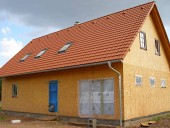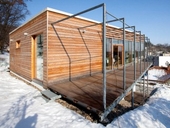At the moment, an amendment is being prepared for the ČSN 73 0540-2 standard. The proposed changes have still not been made public, so this article will not comment in detail about them. We will focus on this issue in future articles. We want to pay attention to chapter 7, which deals with the air permeability of the building's envelope and the tightness of joints, which seem to conform to the current revision of the standard, meaning that, unlike other chapters, these changes are merely cosmetic.
Archiv článků od 1.3.2010 do 6.12.2010
The directive 2010/31/EU on the Energy Performance of Buildings – called EPB, EPBD II or EPBD Recast – was passed last May. EU member countries are obliged to implement these new requirements into their national legislations. The implementation of 2010/31/EU was addressed by a number of seminars during the recent Aqua-therm 2010 trade fair. The following article presents you with the most important facts from the presentations and with links to information that was published before and during Aqua-Therm 2010.
This article is referring to former article called Examination of building underground of block of flats in light of civil heat engineering [3]. It extend previous article by other variants of detail of giving thermal insulation on foundation constructions and basement parts from exterior of building. This article concentrates on solving of these others details of building underground. The type of this block of flats is the system BP-70. This article deals with differences of continuance of temperatures and water vapour pressures on various types of the foundation and basement part of a building with thermal isolation too.
In relation with the transition to European standards, as of March 2010 the standard CSN 73 00 35 Loading of structures becomes valid for the group of standards EN 1990 Basis of design, strength and durability and EN 1991 Actions on structures, constant, variable, extraordinary. The Czech versions of these documents are have been available since 2004-2008. The amendment in the map of snowy regions was received with a relatively high awareness. This amendment resulted in the appendixes CSN 73 0035 and BS EN 1991-1-3 Actions on snow, in effect since 1-1-2006. The current overlapping of CSN 73 0035 with CSN 1991-1-4 Actions on wind thus far, has not resulted in any critical reaction. This contribution should warn designers against an insufficient number of anchors for contact insulation, something that very often occurs. This number depends on the wind load, which in turn, is dependent on normative values. These are listed in a separate standard and are increasing, just like the snow loads.
Thermal properties of enclosure walls have considerable impact on energy consumption of block of flats. Nowadays the proposal of insulation thickness in thermal insulation composite systems is often underestimated. This article is focused on proposal of optimal thermal insulation thickness in light of economy and energy performance.
These times are characterised by the current issues associated with the declining reserves of raw materials and energy sources, with global climate change and the excessive pollution of soil, water and air. All this significantly affect the production of building materials. It is known that the construction and proper operation of buildings is one of the main consumer and energy sources of environmental pollution, and this not only during the building process, but during all the stages of their existence. These trends are reflected in the research and development of new structures and materials. This happens not only in developed countries, but also here, where our focus is slowly shifting from energy-intensive technologies to those based on organic materials. It is actually them who fulfil most of the requirements for sustainable development. Thanks to its origin and good qualities wood should be unambiguously classified.
In the last few years more and more construction companies have started to project and build wooden houses, some even with more than one floor. However, during the design of the structure they often forget the requirements of ČSN 73 0532, that deals with impact and noise insulation. The problem lies in the fact that, in practice, the only methods used are those to determine the weighted sound reduction values for silicate based structure, while they will fail in a wooden construction. This paper presents a computational procedure for determining the airborne sound reduction of cellular type soffits. When designing or renovating buildings a comprehensive account of all aspects should be given (construction, structural, architectural, financial and others). Nowadays the financial aspect is very crucial and therefore, more and more clients are interested in the energy performance of buildings. However, in terms of comfort of the people living in the interior the aspects of acoustics, lighting and heating are more important.
The diagnostics of Atelier DEK measured the tightness of 150 buildings with a Blower-door test. Roughly two thirds of the measured buildings where family houses and from them, more than 60 were built with wood-based technologies. One and two storey buildings with full wall panels and fleeting installation systems were measured, they had ventilated façades and bearing contact insulation systems. We monitored the relationship between the measured intensity of the exchange air value (n50) as determined by the Blower-Dorr test and the construction aspects. The aim was to evaluate the potential of the design principles to achieve the required airtightness. It was also our intention to identify in the different structural principles the characteristics of leakage that on them are often repeated. In this paper we present the conclusions of our analysis.
I am very often asked what issues are still being addressed at the seminars on passive houses, because they have all been already resolved and these buildings are pretty common abroad. The truth is that in other countries the construction of low energy buildings started in the 1990's. However, their ecological, technical and energetic aspects are still evolving. The building structure itself is improving, as well as the insulation systems, heating, ventilation and new building materials and technologies are becoming more sophisticated. It has all gradually come to houses that consume almost no energy. Let's have a look at some of the aspects of the developments.
Sophisticated heating solutions lead to the fact that if at any given stage of the thermal insulation a TRV is properly fit and adjusted and, at the same time, a sophisticated substation solution is installed, one that will “know” how to prepare and maintain the required parameters, mainly during the heating season, then there will be nothing to renovate or solve during the lifespan of the heating station, other than adjusting the temperature and hydraulic parameters correctly.
From a large group of wood-damaging fungi, only a few species participate on degradation of wood built in various building constructions. In spite of that, these species often cause significant damage by their activity. The contribution summarizes knowledge gained during surveys of various wooden constructions of buildings in the last ten years. It describes vulnerable places of constructions with frequent occurrence of wood-damaging fungi, usual extent of damage, causes of creation and development of infestation by wood-damaging fungi and the most common directions of their further spreading. The contribution contains also statistical analysis of generic structure of wood-damaging fungi in particular vulnerable places.
Drainage systems need to be addressed in the first architectural considerations. Many interesting solutions can deal with rain water, but must be prepared in the first proposals for the building and its surroundings. Green roofs, edit terrain, infiltration areas, the building's location in the terrain, etc. may be difficult to solve additionally.
The following contributions, which deal with this problematic, consider the impact of high heat resistance of the walling on the thermal comfort and the design of heating ventilations systems, which are still perceived, as it is the case in buildings with classical walling, therefore, to have lower thermal resistance. For instructions to formulate the effect of walling on the thermal comfort and technical equipment, a general comparison of both the following cases is made, which is simply called building with high thermal resistance of external walls for a low-energy house, and a building with classical walling parameters (e.g. housing estate from the past) as a standard house. The articles are not of exact technical nature and deal with regularly updated dependencies and sometimes refer to previously applicable legal provisions.
The standards ČSN 73 1901 Designing of roofs – basic provisions, ČSN P 73 0600 Waterproofing of buildings – Basic Provisions and ČSN P 73 0606 Waterproofing of buildings – Continuous sheet waterproofing – Basic Provisions have been revised in 2010. What kind of new requirements do these new standards bring? How will their approach change compared to previous regulations? We asked the people behind them about this. The current standards for roof designing have been applied since 1999. According to the proposers of the revision, the many implementations of roofs that have taken place since then have been the source of many new findings, which will be now generalised and reflected in the new standards by clarifying certain provisions or establishing new ones. Developments in European and Czech legislations and standardisations are also necessary to be taken into account.
The attenuation of sound wave with bends is mostly used in the design of noise walls, curtains and barriers along ways with intensive traffic (roads, rail and tram). Noise reduction from stationary sources with curtains is less common because it is always better to place the noisy device in the machine hall. This is then ventilated through a system with big enough dimensions so as to absorb sound, which then blocks the source of sound and the fan noise. Let's look at some specific installations seen in this context as well as calculations of the sound attenuation bend.
The problematic of energy savings should not be limited only to thermal insulation and occasional use of alternative energy sources. The energy used not only for heating, but also for ventilation and air conditioning. Significantly affect the consumption requirements, deciding which areas will be heated and at what temperatures. Energy is needed to produce construction materials, their transportation and eventual waste handling. The lifespan of the proposed construction and the complexity of its liquidation should be one of the essential criteria when deciding on contemplated modifications. It is necessary to consider buildings as architectural heritage.
The article deals with the issue of unwanted condensation of water vapour on internal surface of building structures. Building and physical conditions of surface condensation of water vapour is analysed. It discusses possibilities of technical solutions leading to elimination of the mentioned negative phenomenon – change of use, adjustment of peripheral structures, reaching the required parameters of internal air by natural ventilation or through air-conditioning.
Do you know how to choose a supplier and installers for windows? The article answers to important questions regarding the choice of windows, their frames, glazing, ironwork, sills and accessories such as shadings, etc. The author speaks from personal experiences with suppliers, manufacturers and technical supervisors. The article wants to help people buy windows with the best price/quality ration and ensure their long term satisfaction.
On the beginning of the nineties the various technologies of wood buildings, especially of assembled types, developed. Although in the present time wood buildings have already their acknowledged place even in our country in spite of that we can meet their failures predominantly at the elevational planary wooden facings of load-bearing wooden framing. One such case is also south plywood- facade of family house in Middle Bohemia.
zpět na aktuální články

